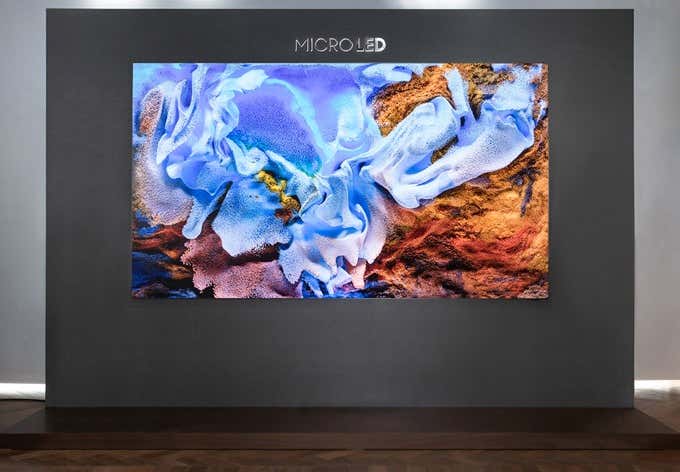We decode all the fancy acronyms
The age of the CRT (cathode ray tube) display is well and truly over. Although some people are rediscovering how great CRTs can be, the vast majority of displays today are flat panels. However, just because modern screens have more or less the same appearance, doesn’t mean that they’re the same under the hood.
There are multiple flat panel display technologies to be found all around you. The specific type of technology in your flat screen display influences everything from how the image is reproduced to what the display costs.

We’ll be looking at the most important current and upcoming panel technologies and the pros and cons of each. Armed with this information, you can make an informed decision the next time you have to purchase a television or monitor.
Twisted Nematic (TN) LCDs
TN panels are the most basic form of LCD (Liquid Crystal Display). The name refers to the basic principle of how all LCDs work. A special liquid crystal material twists into alignment or out of alignment based on an electrical current. In this way these displays can reproduce full-color images by varying the amount of red, green or blue light passing through each pixel.
Modern TN panels are much better than those early models that really made you regret switching from CRT, but these days general audiences would be happy with a typical mainstream TN screen.
There are two main advantages to choosing a TN screen. The first is a fast response time. That’s a measurement of how long it takes for the display to change from one state to the next. Slow response times can lead to blurry images and ghosting. This is why competitive gamers tend to favor TN panels, since it’s not uncommon to find ones with a response time under a millisecond.

The second major advantage of TN panels is price. With all other things being equal, TN screens are almost always less expensive than other technologies.
Unfortunately, there are problems. They have relatively poor viewing angles, can appear washed out and don’t reproduce vibrant, accurate colors. What’s worse, IPS displays (which we’ll discuss next) can now reach similar response times without compromising on image quality.
In-plane Switching (IPS) LCDs
IPS technology was one of the new LCD approaches developed specifically to address the major weaknesses in TN technology. IPS displays offer accurate color reproduction, vibrant colors and fantastic viewing angles.
IPS technology has also essentially eroded the response time advantage of TN screens, but that depends on the specific model. Be sure to check the response time specification on any IPS screen you’re interested in.
Related: Be sure to check out our in-depth comparison of IPS vs. Nano IPS displays.
One area where IPS screens fall a little short compared to TN panels is in the reproduction of blacks. However, poor black reproduction is a problem all LCD technologies share. It’s an issue that’s being improved across the board.

IPS monitors are generally the best option for anyone who works in video editing, photo editing, design and other professions where color accuracy is important. Although you do still have to calibrate your IPS display to really nail the right settings.
IPS screens are also suitable for gamers, especially those who don’t care for refresh rates above 60Hz. While high refresh rate IPS screens do exist, they carry a stiff price premium compared to equally speedy TN panels. Overall, when it comes to computer monitors, IPS displays are the best choice for most users.
Vertical Alignment (VA) LCDs
VA panels put the liquid crystals that all LCDs use into a different orientation. That is, they are aligned vertically relative to the glass of the display when a current is applied. This changes what happens to light as it passes through the display compared to the TN and IPS approaches.
One of the most important advantages of VA panels is the fact that they produce the best black levels among LCD displays. This flat panel display design also offers much wider viewing angles than either TN or IPS.

This is why VA panels are often used in televisions, rather than computer monitors. Computer users generally work solo and view the screen from the optimal central viewing position. Televisions are watched by groups of people, with some looking at the screen from an off-axis position. VA panels minimize color shift and other distortions for those viewers sitting far to the left or right of the screen.
There are two subtypes of VA flat panels: MVA (Multi-domain Vertical Alignment) and PVA (Patterned Vertical Alignment)
MVA flat panel display technology was developed as a middle-ground between TN and IPS displays. With the improvements of both TN and IPS, the need for this compromise is lessened, but modern MVA technology has its place in the form of “Advanced” and “Super” MVA technology.
PVA technology is proprietary to Samsung and you’ll find that they’ve made various proprietary tweaks to it that improve things like color accuracy or brightness.
OLED Flat Panels
OLED or Organic Light-Emitting Diode displays use a completely different principle than LCDs. They consist of pixels that contain organic chemicals which produce light. LCDs use a backlight through the panel to make the display visible. This makes it hard for LCDs to produce true black, since there’s always light shining through the panel. OLEDs achieve perfect black levels by simply switching off those pixels.
Premium smartphones and high-end TVs make use of OLED flat panel display technology. It’s superior to LCD technology in almost every way, apart from a higher tendency to suffer “burn-in”, where an image is retained on the screen. Oled can also be made incredibly thin, making for stylish wall-mounted TVs or ones that are easily hidden when not in use.

OLEDs are still quite expensive, but prices have come tumbling down over the years. LG in particular sells OLED televisions with prices that can almost be considered reasonable.
That being said, LCD manufacturers have been making improvements to their technology to bring it closer to what OLED can do, at a much lower price. Samsung’s cheekily-named QLED televisions is one example of this.
Mini LED Flat Panels
Mini LED flat panels are just standard LCD panels which can be of any type. The difference comes from the backlight technology. At first, LCDs were backlit with fluorescent tube lights, which produced uneven brightness and various other problems. Then LED backlights, dotted around the edges of the screen dramatically improved the situation. Today higher-end TVs use “local dimming” where numerous LEDs are placed behind the panel across its surface.

For example, a TV might have 12 dimming zones, which allows for better representation of true black thanks to precisely controlled brightness in each zone.
Mini LEDs are many times smaller than those existing LED arrays, making it possible to put hundreds and perhaps thousands of local dimming zones in a TV. They promise to approach the visual prowess of OLEDs but at a much more affordable price. Especially for the larger displays.
microLED Flat Panels
Finally, we have microLED flat panel display technology. You can’t buy a display using this technology yet, but it probably won’t be long. If you thought mini LEDs were small, hold on to your hat. microLEDs are so small that they can be used as pixels themselves. That’s right, a microLED display doesn’t have an LCD panel. You’re looking at millions of microscopic lights.

This technology promises superior image quality to OLED displays, without the decay organic compounds suffer over time. If you want to know more, check out OLED vs MicroLED: Should You Wait? for an in-depth breakdown.
Which flat panel display technology do you think offers the best overall experience? Do you care mainly about cost or performance? Are there other display technologies you think should be included in this list? We’d love to hear from you in the comments.




